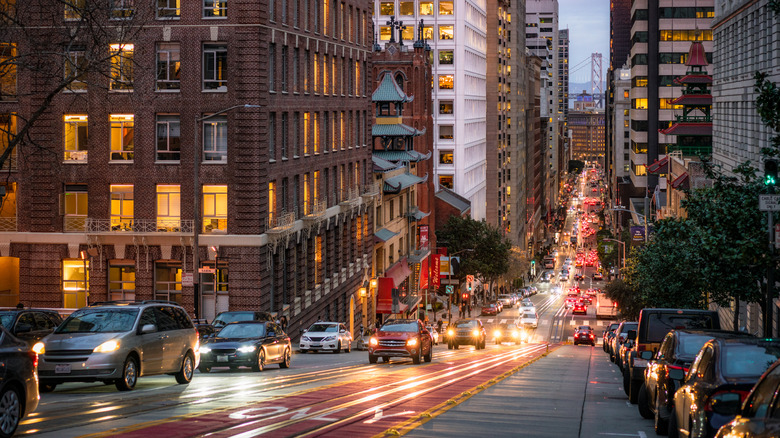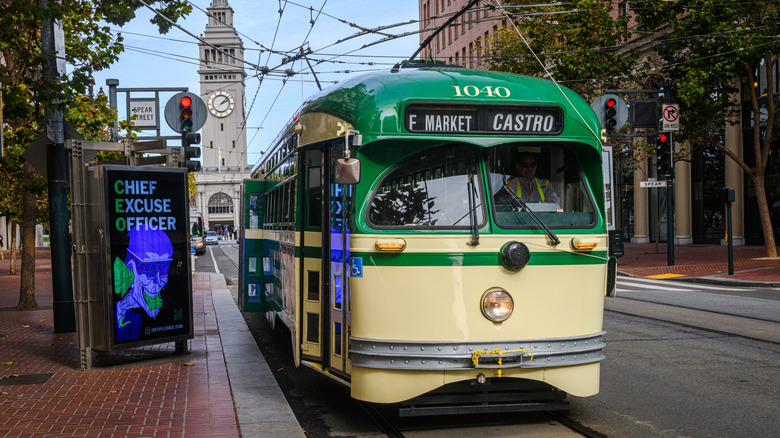This Fun And Iconic Mode Of Transportation Is The Perfect Way To Explore San Francisco
At $9 a ride at the time of writing, San Francisco's cable cars aren't the cheapest public transportation option, but how else are you going to hang out of a moving vehicle on the city's rolling hills? It's not every day you get to see the world's last manually operated cable car system in action, either. This means there's a grip person standing in the center aisle, ringing the bell and working the lever that moves the car along its underground street cable. The technology, first implemented here in 1873, is part of the amazing history behind San Francisco's steep streets. It's earned the city's cable car system the unique distinction of being a National Historic Landmark ... on wheels.
In a report on KPIX, the Bay Area's first TV station, CBS News noted that riding the cable car is often the first thing tourists do in San Francisco. More than just a piece of living history, the cable car can be something of a thrill ride as it climbs and dips like a slow-moving (9.5-mile-per-hour) roller coaster. Boarding one at its first stop, you might also see a long line fit for a popular amusement park coaster. Take your chances and board somewhere else down the line, and rather than sitting, you might find yourself hanging off the side with the wind in your hair.
The cars have benches that face outward, or you can cling to a pole as they take you on a breezy ride through the hills. You'll need to exercise caution, of course, even if the trend of set-jetting, or movie-inspired travel, has brought you to San Francisco. While it's fun mimicking Nicolas Cage, you don't really want to reenact the over-the-top action scene in "The Rock" where all the passengers come tumbling out of a cable car.
Ride the city's three cable car lines to sightseeing spots
With a visitor passport from the San Francisco Municipal Transportation Agency (SFMTA), you can enjoy unlimited rides on the Muni network, which includes buses, streetcars, cable cars, and Metro rail lines. A one-day, three-day, or seven-day Muni passport costs $15, $35, and $47, respectively, at the time of writing. Use one to get started on the oldest of San Francisco's three cable car lines, the California line, which runs the length of California Street between Van Ness Avenue and Drumm Street. One of its first inbound and last outbound stops, at the intersection of California and Hyde, is three blocks away from the historic hotel featured in Alfred Hitchcock's "Vertigo."
The stop at California and Taylor puts you on the doorstep of Grace Cathedral, where labyrinths meet stained glass and Gothic architecture. Disembark at California Street and Grant Avenue, and you'll be in Chinatown, just two blocks from the Dragon Gate and its stone guardian lions. California and Battery unloads across the street from Tadich Grill, the city and state's oldest restaurant. California and Davis (inbound) or Drumm (outbound) are both a short walk from the city's famous Ferry Building, with its 245-foot clock tower and neon-red Port of San Francisco sign.
San Francisco's two other cable car lines each board at the Powell Street turnaround, where the cars do a 180 and go the other way. One point of interest along the Powell-Mason line is the free Cable Car Museum in the car barn and powerhouse on the corner of Mason and Washington. Inside, you'll find antique cars and a downstairs viewing room where you can see wheels called sheaves guiding the cables under the street. Mason and Filbert is a half-mile walk from Coit Tower, which offers panoramic views atop Telegraph Hill.
Connect to landmarks via cable car and streetcar stops
The Powell-Hyde line splits off parallel to the Powell-Mason route, with one highlight being the stop at Hyde and Lombard. It puts you at the top of a hill overlooking the eight switchbacks of Lombard Street, which holds the Guinness World Record to support its "Crookedest Street in the World" nickname. The line's final outbound stop, Hyde and Beach, is right around the corner from Ghirardelli Square, where you can enjoy a hot fudge sundae at the chocolate maker's original shop. Here, the cable car does an about-face on a turntable while some riders head off the other direction to Fisherman's Wharf and the fun-filled Pier 39.
San Francisco's cable cars shouldn't be confused with its historic streetcars, which can be useful for reaching other local landmarks. Streetcars have trolley poles, connecting their roofs to overhead electrical wires and giving their old, bus-like frames a more tethered appearance than cable cars. This is why they're also sometimes called trolleys, per Market Street Railway, the nonprofit organization that helps preserve the SFMTA-operated streetcars and cable cars.
Since the pandemic, only one of San Francisco's two streetcar lines is back in service. That's the F-line, or the F Market and Wharves line, which runs up and down Market Street and the waterfront roadway of the Embarcadero. From Market and 3rd, it's a straight, 1-mile shot to Oracle Park, where you can see the San Francisco Giants play baseball. Market and 5th trades passengers with the nearby Powell Street cable car turnaround, before the streetcar hooks around and stops in front of the Ferry Building. When you get to Fisherman's Wharf (at Jones and Beach), you'll see how the streetcar and cable car form a rough loop as they facilitate memorable trips around San Francisco.


